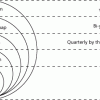Strategic advice to leverage new technologies
Technology is at the heart of nearly every enterprise, enabling new business models and strategies, and serving as the catalyst to industry convergence. Leveraging the right technology can improve business outcomes, providing intelligence and insights that help you make more informed and accurate decisions. From finding patterns in data through data science, to curating relevant insights with data analytics, to the predictive abilities and innumerable applications of AI, to solving challenging business problems with ML, NLP, and knowledge graphs, technology has brought decision-making to a more intelligent level. Keep pace with the technology trends, opportunities, applications, and real-world use cases that will move your organization closer to its transformation and business goals.
Recently Published
Five Levels of Planning: The Executive Perspective
Several years ago, I wrote a short article on planning in agile projects that dispelled the notion that agile practices did not include much planning. 1 Agile has moved on,
The Friction of Agile
It is quite a common occurrence in my practice: I step into an engagement that involves hundreds of developers, testers, product managers, project managers, architects, user design specialists, and quite a few other disciplines, from all over the globe. The time zone difference between some of their most important sites is 10, 11, or 12 hours. The expectations of whatever agile software method I bring to bear is that it will improve quality, productivity, and time to market.
Beyond SOA
Do We Have to Hug? Part I — Building Collaboration
The Friction of Agile
It is quite a common occurrence in my practice: I step into an engagement that involves hundreds of developers, testers, product managers, project managers, architects, user design specialists, and quite a few other disciplines, from all over the globe. The time zone difference between some of their most important sites is 10, 11, or 12 hours.
Principles of Design: Part II
In my last Advisor ("Principles of Design: Part I" 14 September 2011), I introduced
How 21st-Century Enterprises Grow
It's your first briefing from the CIO:














